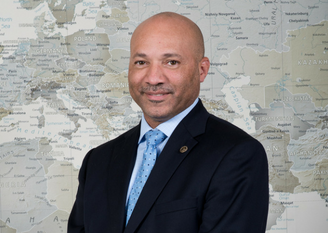By Christopher Washington, Ph.D., Provost and Executive Vice President, Franklin University

Christopher Washington, Ph.D., outgoing Chair of the Global Ties U.S. Board of Directors, reflects on his experience on the Global Ties U.S. Board, and imagines a future that leverages technology to augment and expand leadership exchanges.
Over the past six years I’ve served on the Global Ties U.S. Board of Directors, I can describe my journey as a labor of love, a textbook worthy lesson in connecting with diverse others, and as a learning lab in sense-making and adapting to disruption.
My interactions with so many of you at our national meetings, inspired me to deepen my familiarity with our network of citizen diplomats. I was able to visit a number of our Community-Based Members (CBMs), including Global Ties Detroit, Global Pittsburgh, Global Ties Alabama, and Global Ties Miami. I attended Diplomacy Begins Here Summits in Cleveland and in Louisville, where I also had the privilege of hosting a panel of HR executives. I even hosted a Global Ties U.S. board meeting in my hometown of Columbus, Ohio. In getting out and about and by serving on the board, I’ve discovered a treasury of lifelong friendships in CBM leaders such as Martin Baier, Jacqui Shipe, and Jackie Miller, and in National Program Agency (NPA) leaders such as Patricia Harrison, Ph.D. of World Learning and Henry Collins of Meridian International Center, to name a few. I’ve met and befriended many unforgettable International Visitor Leadership Program (IVLP) alumni including Ricardo Vanilla, Pascal Duparyet, Yasmine Hasnaoui. Ph.D, Runcie C.W. Chidebe, Gruia Bumbu, and Michael Bvanyangu Mabwe. Both through our visitors and through your eyes, I’ve witnessed the power and potential of international exchange programs as relationship building tools that create a more peaceful and prosperous world.
One of the many high points of my experience was helping to select our exceptional CEO, Katherine Brown, Ph.D. Katherine has sailed the Global Ties U.S. ship to luminescent shores during an extended period of social and economic volatility and uncertainty: through a government shutdown, budget uncertainties, and a global pandemic that resulted in a great international lockdown. Under Katherine’s leadership we faced these challenges head on and continue to plan for the future, and fulfill our mission work in novel ways.
The IVLP is a strong pillar of public diplomacy. However, the recent pandemic and restrictions on visits to the U.S. has disrupted the continuity of how the 80-year-old program operates. Like any great organization confronting their limitations, Global Ties U.S. leaders have been moved to ask ourselves, “so what’s next?” How can we effectively achieve our citizen diplomacy goals given the current travel restrictions? How can we continue to engage current and emerging leaders around the globe, enable them to experience this country and its citizens firsthand, and facilitate lasting relationships between them and U.S. counterparts in a variety of fields?
As an educator who has led one of the more advanced academic institutions in the field of open, flexible distance education, I can speak first hand to the potential uses of information and communication technology (ICT) in supporting education, leadership development, and the execution and expansion of international relationships. I’ve previously noted this potential during an interview for an article entitled “Looking to the Future,” published in the December 2015 issue of The Foreign Service Journal.
It is well within our imagination and capability to consider using ICT and human machine collaborations as cost effective means to enhance and expand professional exchange programs. Just look around. Professionals in nearly every occupation have developed “new media literacies,” learned to use social platforms to purposefully connect with colleagues at great distances, and generated content that is made accessible to a wide audience over the internet. Social media platforms are popularly used to get acquainted, nurture interactions, share information, and for project collaborations. More sophisticated users of ICT are tapping into artificial intelligence to structure learning tasks, and engaging in simulated and emergent digital environments to take tours of physical spaces and tackle collaborative tasks in 3D virtual spaces. In the professional exchange world ICT and social platforms can be used to create and host virtual intercultural events and experiences.
After this pandemic period, I suspect that the IVLP will continue to have travel to the U.S. as an important programmatic feature. However, if past is prologue, then it is reasonable to expect that these experiences will become increasingly expensive and limited number to a fixed number of people who the program can afford to send to the United States. Virtual programs have the potential to open the door to many more participants, to re-engage alumni and expand the participation of community resources, and support extended project collaborations.
So, what is next? With our hearts and minds focused on the purpose of our public diplomacy work, and with increasing support for virtual exchange activity, now is a great time for the Global Ties Network to evolve the technological means by which we complement our best efforts, expand access to exchanges, and assure that our soft power diplomacy has a firm impact in the coming decades.
